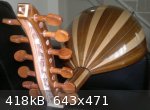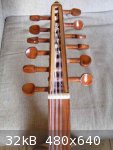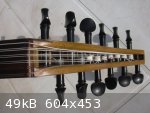smast
Oud Addict
  
Posts: 28
Registered: 8-1-2010
Member Is Offline
|
|
A peg solution
Hello all,
I posted a few months back about tuning issues on a Moroccan oud and got a huge amount of help from people so thanks again! I got myself an Egyptian
oud (I'm pretty sure it's made by Sayed Fathy Amin, pictures posted), which is far easier to keep in tune and I have also managed to use it for
performance, though changes in humidity and temperature do affect it a lot (as you would expect). Yesterday, my rehearsal room went up to 77% humidity
at about 25c and it was very difficult to keep it in tune.
I'm pretty sure the pegs are not rosewood or ebony and I recently made enquiries about the cost of replacing them (I'm not that experienced in
instrument maintenance myself), for which I was quoted £100 ($160), plus pegs. It was from a very good luthier in London. I know I could get hold of
some viola pegs pretty cheaply.
Staying in tune live does concern me, as I play with a guitarist so being in tune with myself is not the only concern. So far I've had no big issues
but you never know what the conditions are going to be like in a venue.
I'd be very interested and grateful to hear people's opinions - should I:
1) Do nothing and get over it!?
2) Have the pegs replaced with ebony/rosewood?
3) By an electric oud with machine heads? I like the look and feel of a real oud but if my only option is to go electric, I'll have to go ahead and do
it. I'm using a k and k dual spot with a DI box, with good results at the moment.
Thanks!



|
|
|
David.B
Oud Junkie
    
Posts: 640
Registered: 9-5-2009
Location: France
Member Is Offline
Mood: Renaissance
|
|
Hi smast,
For sure it is not ebony or rosewood. I'm not a specialist but if I remember well I read somewhere on this forum that ebony "sands" the hole which is
softer... But more important : is it me or pegs are not straight (first photo) ?
|
|
|
smast
Oud Addict
  
Posts: 28
Registered: 8-1-2010
Member Is Offline
|
|
Hi David,
Thanks for your reply. Yes - I was pretty sure they are a softer wood. My fault - I posted a photo of the same model but I don't think it's my actual
oud. The photos posted were by the seller and I think it may be a different instrument. Here is the head of mine - I can see what you mean about the
previous photo - it doesn't look quite straight.

|
|
|
David.B
Oud Junkie
    
Posts: 640
Registered: 9-5-2009
Location: France
Member Is Offline
Mood: Renaissance
|
|
Yes, this pegbox looks fine. Ebony or rosewood would help the oud to keep in tune, but of course, you've got to make the holes perfectly fit to the
pegs. Also, strings are an important factor. Personally, I use Daniel Mari and the G strings are systematically out of tune, temperature, humidity...
Question of matter I guess, because all the others keep in tune much longer.
|
|
|
smast
Oud Addict
  
Posts: 28
Registered: 8-1-2010
Member Is Offline
|
|
That's good! Yes, I certainly wouldn't trust myself to do this job - I'd take it to a luthier... Is it worth doing this on an oud of this level?
Bearing in mind I'd have to pay for it as I don't have the tools myself... If this would make it much more reliable, I'd be prepared to do it.
Thanks for your help
|
|
|
roland
Oud Admirer

Posts: 9
Registered: 11-5-2003
Location: belgium
Member Is Offline
Mood: No Mood
|
|
oud pegs
Hello Smast,
May be this article will interest you:
http://oudluthier.blogspot.com/2008/10/traditional-meets-technology...
Best whishes
|
|
|
smast
Oud Addict
  
Posts: 28
Registered: 8-1-2010
Member Is Offline
|
|
Thanks, Roland - I'd heard of those but they slipped my mind (no pun intended!). I hadn't ever seen exactly how they work. They are a bit expensive,
though! It seems they would be to get them shipped to the UK.
|
|
|
smast
Oud Addict
  
Posts: 28
Registered: 8-1-2010
Member Is Offline
|
|
I think I may try these, referred to in an earlier post: http://www.stewmac.com/shop/Tuners/Dulcimer_tuners/Grover_Champion_...
I know it's not very authentic but hopefully it'll solve the problem... and they're not as expensive as the perfection pegs, etc.
|
|
|
fernandraynaud
Oud Junkie
    
Posts: 1865
Registered: 7-25-2009
Location: San Francisco, California
Member Is Offline
Mood: m'Oudy
|
|
I dunno. If the luthier wants to charge you that much, I'd consider other options. And other issues. You never told us how much it slips. That's very
different from stretching. The strings will stretch with humidity changes, and so will the wood.
What you are complaining about may not be corrected by changing pegs. I find that PVF strings are more stable than nylon after they settle in. But
then the wound strings are the ones that seem to stretch. It doesn't matter if the pegs are even completely slip-proof, you will still have to touch
up the tuning as your environment changes. It's not THAT difficult. If the pegs are not slipping, and can be made to be reasonably smooth yet hold by
keeping them pushed in and with a little bit of peg dope or soap/chalk, then the pegs are fine, and they are are not the problem.
You may have to live with the way the wood and strings react to the environment. Or get a different oud that is less susceptible to those effects.
Like a rigid frame electric with machine tuners (for good measure).
But by then you may not like the sound. Part of the character of an instrument is in those very things that respond to the surroundings.
|
|
|
smast
Oud Addict
  
Posts: 28
Registered: 8-1-2010
Member Is Offline
|
|
I think there are two slipping issues - one is that a couple of the pegs have to be pushed in a lot and sometimes slip (loosen to almost slack)
overnight (or occasionally during tuning) but I guess soap/chalk should solve that. Compared to tuning a violin, it's a difficult experience - the
pegs feel a little flimsy and don't respond too well. But then my violin has ebony pegs and these are probably boxwood. It seems as though if the
pegbox were smoother and the pegs a little better, it might improve things.
However, the other issue, as you suggest, is probably the oud reacting to the environment. It was unbearable the other night when it probably changed
by about 20% relative humidity during a practice. This is pretty unlikely to happen in any other situation though. It seemed as though once I'd tuned
up from C to C, the other C wasn't quite right, and then the G's seemed a little out, etc. The soundboard is not lacquered so I suppose it will absorb
and give out a lot of moisture. And I am using nylon strings too.
As you say, it is expensive ($160) for a re-pegging job but London is one of the most stupidly expensive places on earth! I could try the job myself
but my experience is only of very basic instrument maintenance. I could make other enquiries of luthiers that I've not used before.
If you think the champion/friction pegs would not work, I won't vandalise my instrument for no reason ;-)
Thanks again for your help.
|
|
|
smast
Oud Addict
  
Posts: 28
Registered: 8-1-2010
Member Is Offline
|
|
Having just tuned up, I had to revisit the low C three times before it would stay at C (using an electronic tuner). I tuned it, then moved on to
another course, went back to it and found it had slipped to nearly B, retuned it, revisited it after I had tuned the other strings and found it was
still a little flat. After playing for about five minutes, one string on a few courses was a little flat. The pegs stick a lot too. Sorry, just trying
to paint a picture of what it's like. In the past I haven't been quite so paranoid about checking with the tuner so it's possible I'm more aware of it
now.
|
|
|
David.B
Oud Junkie
    
Posts: 640
Registered: 9-5-2009
Location: France
Member Is Offline
Mood: Renaissance
|
|
Before you tune do you stretch courses? Do you put in order the strings in the pegbox like on the photo? At last, do you tune the oud like that : G
courses first, then c, D, AA, CC, FF? If your pegs do not move the problem comes from the strings... And if strings are new it's OK, you've got to
wait one week before the tuning stays stable.

|
|
|
smast
Oud Addict
  
Posts: 28
Registered: 8-1-2010
Member Is Offline
|
|
Hi David, I don't stretch courses before tuning, no. I hadn't realised I should do that each time I tune. Although I have strung the oud as in the
photo (http://www.oudcafe.com/stringing_and_tuning.htm), I don't tune in the order that you suggest. Thank you - I will try that out. The strings are a
few months old.
|
|
|
David.B
Oud Junkie
    
Posts: 640
Registered: 9-5-2009
Location: France
Member Is Offline
Mood: Renaissance
|
|
To stretch courses is not always necessary, but it can remove the residual tension between the pegs and the nut. I put C instead of F2, not so
important, but if you tune g2 g1, c2 c1, d2 d1, A2 A1, C and F2 F1 (my way), you will keep the oud tuned during the whole process, because you respect
the implantation of pegs. Many courses are laid on g2, so you move a little bit the whole tune when you adjust it at the end of the process... Hope
you see what I mean 
|
|
|
smast
Oud Addict
  
Posts: 28
Registered: 8-1-2010
Member Is Offline
|
|
Thanks, David - that makes a lot of sense! 
|
|
|
fernandraynaud
Oud Junkie
    
Posts: 1865
Registered: 7-25-2009
Location: San Francisco, California
Member Is Offline
Mood: m'Oudy
|
|
... but if your strings are stretched, and the pegs are slipping, you might have to consider replacing the pegs. This is standard for an average oud.
I have one that I have been considering and considering re-pegging, but everytime I consider I reconsider and just shove them pegs in until they hold.
Viola pegs can work, and you can get beautiful rosewood or whatever hard wood pegs in the US anyway for about a dollar a piece. Or you might find a
set of 12 oud pegs. It's a matter of how the holes are tapered and how wide at entry. Lute/oud pegs are usually tapered about 16:1, while violin/viola
pegs are around 30:1. Either is OK, the 30:1 requires less pushing in, once it's done it tends to just work, but can split a pegbox more easily they
say. I'd go with 30:1.
You'd need a peg shaver and a reamer at the same taper, say 30:1, so you can ream the holes and get the pegs dialed in, as they are not perfectly
tapered by the maker. You can find a matched tool set like that around fifty euros, or the chinese will sell ya a set for fifty bucks plus twenny to
ship. So the new pegs and tools will cost around a hundred dollars. But think of all the holes you can ream! And you can also just touch up the hole
and touch up the existing pegs once you have the tools. It's not that hard to do the work, and you have a little margin before you run out of peg
length.
I started touching up my guilty oud with a 30:1 reamer and a shaver, and so far have done 4. One of these days I'm a' planning to do the rest. It's
delicate to work with flawed stuff, not much material to work with, it's like doing neurosurgery on a village idiot, but if you shave them too much
and ream too much, so that the peg goes ALL the way in (oops), that's when you pull out your virgin viola pegs and start from scratch.
It takes a bit of shaving to get viola pegs slimmed down! I didn't know rosewood was THAT hard. But those banjo dulcimer pegs look like a very ugly
last resort, like using Billy Bob's old braces to rebuild when the neurosurgery didn't work out. And the real planetary pegs are beautiful, but
unconscionably expensive. It's cheaper to get a new oud with good pegs. So now do you understand why it's beneficial to be understanding of
imperfection? And that's why those pegs aren't any better.
|
|
|
smast
Oud Addict
  
Posts: 28
Registered: 8-1-2010
Member Is Offline
|
|
Thanks, Fernand! Maybe now is the time to do my first bit of proper maintenance. I soldered an acoustic guitar pickup for the first time recently so
maybe that was in preparation for bigger things! The last thing I want is an ugly last resort that doesn't even work so I think I may try and get
wood-working. Even viola pegs are expensive in the UK (over $2) but I saw some rosewood Turkish oud pegs much cheaper; a complete set. Might these
work or would they be too small for an Arabic oud? Thanks again.
|
|
|